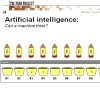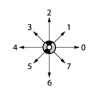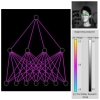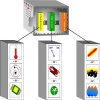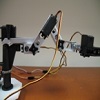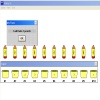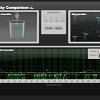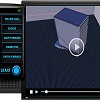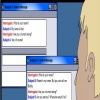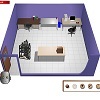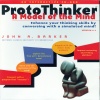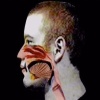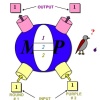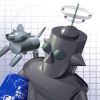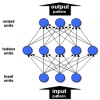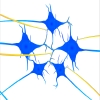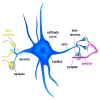Curriculum Modules - by Author
David Leech Anderson
This is some example text to demonstrate how it will flow within the module's description section. The title section is used for the title/link to page (thumbnail will also link to page), and this section is to describe the lab. If there is a link in the description itself, it will look like this.
Chain codes are a kind of computer program that can be used to represent the shape of objects. Seven hands-on activities show how to write simple chain codes and explain their application to computer vision.
There are both classical AI programs and neural networks that can process visual information about the world and give machines the ability to "see." This module explores different approaches to computer vision.
Functionalism asserts that minds and their mental states (pains, beliefs, etc.) are defined by their function (or software design) not their physical make-up (hardware). This means that machines as well as biological organisms could have minds..
The Iris 1.2 Robotic Arm runs on software written by The Mind Project robotics team. The module has detailed instructions for building and programming the arm and for using it in the classroom.
Larry Learner is an artificial intelligence program that plays the game "Last One Loses." There are two versions of Larry -- one version is programmed to win. Another version doesn't know how to win, at first, but it learns..
The Müller-Lyer Illusion is one of the most famous examples of the human visual system misinterpretting the world. Become a subject in an online Müller-Lyer experiment. Try to explain why this happens..
Computers play a central role in artificial intelligence, robotics, and in modeling various capabilities of minds/brains. But what is a computer? Are all computers the same? This module answers these questions..
After receiving a detailed introduction to Parkinson's Disease, explore interactive animations that elucidate two competing theories that seek to explain mysterious features of the disease.
The computer processing in virtually all robots is digital. What significant differences would there be in a robot that was controlled by an analog, water computer? Compare two robots which behave the same but one is digital, one is analog.
This is a comprehensive introduction to robotics that focuses on the use of robotics in medicine and that features three stand-alone virtual robotics labs.
This is a brief introduction to the scientific study of visual perception, featuring animations that generate visual phenomena requiring scientific analysis.
John Searle's Chinese Room Argument challenges one of the most popular theories of the mind. Many passionately defend the argument; many others viciously attack it. Come and try to figure out what all the fuss is about..
Alan Turing proposed a fascinating test for "machine intelligence" in 1950 which remains at the center of controversy. Offered here is a flash animation showing one way the test might be conducted and the types of questions that might be asked..
Students become field anthropologists and conduct a study on cultural differences in the use of color terms. Students learn current research methods and struggle with the long-standing dispute between universalists and relativists.
This is a virtual neuroscience lab where students perform an experiment studying the relationship between dopamine levels and cocaine seeking behavior in a virtual rat.
Students in this immersive lab measure dopamine levels in rats with Parkinson's symptoms to compare competing theories which seek to solve the mystery of how the brain compensates for the death of dopamine neurons.
You build a "top-down", write scripts to control its motors, and train its AI software so that it will perform interesting tasks. After creating the virtual robot, join the Mind Project Team and build a physical version of the same Iris.4 robot.
In this virtual experience students become a neuroradiologist who performs a coiling procedure on a patient suffering from a brain aneurysm. Students learn not only about strokes but the importance of technology in diagnostic medicine.
"Is it possible to build a person?" Various criteria of personhood are considered and students are challenged to develop their own criteria and to judge whether or not those properties could be “mechanized” and built into a machine..
Robert Thomas Arrigo
This is some example text to demonstrate how it will flow within the module's description section. The title section is used for the title/link to page (thumbnail will also link to page), and this section is to describe the lab. If there is a link in the description itself, it will look like this.
Larry Learner is an artificial intelligence program that plays the game "Last One Loses." There are two versions of Larry -- one version is programmed to win. Another version doesn't know how to win, at first, but it learns..
The Müller-Lyer Illusion is one of the most famous examples of the human visual system misinterpretting the world. Become a subject in an online Müller-Lyer experiment. Try to explain why this happens..
You build a "top-down", write scripts to control its motors, and train its AI software so that it will perform interesting tasks. After creating the virtual robot, join the Mind Project Team and build a physical version of the same Iris.4 robot.
John Barker
ProtoThinker (or "PT") is an "artificial agent" -- a computer program that interprets what you say to it, believes and remembers what you tell it, and decides to do things only if those actions are consistent with PT's moral commitments.
Clay Beckner
ProtoThinker (or "PT") is an "artificial agent" -- a computer program that interprets what you say to it, believes and remembers what you tell it, and decides to do things only if those actions are consistent with PT's moral commitments.
Kari Cox
John Searle's Chinese Room Argument challenges one of the most popular theories of the mind. Many passionately defend the argument; many others viciously attack it. Come and try to figure out what all the fuss is about..
Alan Turing proposed a fascinating test for "machine intelligence" in 1950 which remains at the center of controversy. Offered here is a flash animation showing one way the test might be conducted and the types of questions that might be asked..
Students become field anthropologists and conduct a study on cultural differences in the use of color terms. Students learn current research methods and struggle with the long-standing dispute between universalists and relativists.
You build a "top-down", write scripts to control its motors, and train its AI software so that it will perform interesting tasks. After creating the virtual robot, join the Mind Project Team and build a physical version of the same Iris.4 robot.
Josh de Leeuw
With videos of actual robots, users are able to experiment with thousands of different programming combinations ("hierarchies") to solve a robotic-design challenge in behavior-based robotics.
William E. J. Doane
This is an online version of portions of the Steve Weisler & Slavko Milekic book Theory of Language originally published in CD-ROM and print form by MIT Press. Effective activities and many videos enhance this linguistics textbook..
Paul Garris
After receiving a detailed introduction to Parkinson's Disease, explore interactive animations that elucidate two competing theories that seek to explain mysterious features of the disease.
This is a virtual neuroscience lab where students perform an experiment studying the relationship between dopamine levels and cocaine seeking behavior in a virtual rat.
Students in this immersive lab measure dopamine levels in rats with Parkinson's symptoms to compare competing theories which seek to solve the mystery of how the brain compensates for the death of dopamine neurons.
Darci Harland
After receiving a detailed introduction to Parkinson's Disease, explore interactive animations that elucidate two competing theories that seek to explain mysterious features of the disease.
This is a virtual neuroscience lab where students perform an experiment studying the relationship between dopamine levels and cocaine seeking behavior in a virtual rat.
Students in this immersive lab measure dopamine levels in rats with Parkinson's symptoms to compare competing theories which seek to solve the mystery of how the brain compensates for the death of dopamine neurons.
Andrew Todd Kenning
This is a virtual neuroscience lab where students perform an experiment studying the relationship between dopamine levels and cocaine seeking behavior in a virtual rat.
Tony Kuzola
Larry Learner is an artificial intelligence program that plays the game "Last One Loses." There are two versions of Larry -- one version is programmed to win. Another version doesn't know how to win, at first, but it learns..
Ken Livingston
With videos of actual robots, users are able to experiment with thousands of different programming combinations ("hierarchies") to solve a robotic-design challenge in behavior-based robotics.
Michael Marsalli
McCulloch and Pitts developed a mathematical model of a biological neuron. Learn about the original MCP neuron as well as further developments that would eventually lay the foundation for today's connectionist networks (artificial neural nets).
Slavko Milekic
This is an online version of portions of the Steve Weisler & Slavko Milekic book Theory of Language originally published in CD-ROM and print form by MIT Press. Effective activities and many videos enhance this linguistics textbook..
Elisa Palmer
This is a virtual neuroscience lab where students perform an experiment studying the relationship between dopamine levels and cocaine seeking behavior in a virtual rat.
Students in this immersive lab measure dopamine levels in rats with Parkinson's symptoms to compare competing theories which seek to solve the mystery of how the brain compensates for the death of dopamine neurons.
In this virtual experience students become a neuroradiologist who performs a coiling procedure on a patient suffering from a brain aneurysm. Students learn not only about strokes but the importance of technology in diagnostic medicine.
Win Phillips
Some computer scientists say that in the next 40 years we will be able to transfer our minds into a robot and live, virtually forever. In this monograph, Win Phillips examines the plausibility of this "extraordinary" claim. (Image by Nancy Stahl).
Gordon Redding
There are both classical AI programs and neural networks that can process visual information about the world and give machines the ability to "see." This module explores different approaches to computer vision.
The Müller-Lyer Illusion is one of the most famous examples of the human visual system misinterpretting the world. Become a subject in an online Müller-Lyer experiment. Try to explain why this happens..
Michael Romanzow
Students become field anthropologists and conduct a study on cultural differences in the use of color terms. Students learn current research methods and struggle with the long-standing dispute between universalists and relativists.
You build a "top-down", write scripts to control its motors, and train its AI software so that it will perform interesting tasks. After creating the virtual robot, join the Mind Project Team and build a physical version of the same Iris.4 robot.
Andy Schmidgall
This is some example text to demonstrate how it will flow within the module's description section. The title section is used for the title/link to page (thumbnail will also link to page), and this section is to describe the lab. If there is a link in the description itself, it will look like this.
Larry Learner is an artificial intelligence program that plays the game "Last One Loses." There are two versions of Larry -- one version is programmed to win. Another version doesn't know how to win, at first, but it learns..
Lionel (Lon) Shapiro
Chain codes are a kind of computer program that can be used to represent the shape of objects. Seven hands-on activities show how to write simple chain codes and explain their application to computer vision.
James Stanlaw
Students become field anthropologists and conduct a study on cultural differences in the use of color terms. Students learn current research methods and struggle with the long-standing dispute between universalists and relativists.
Allison Steinhauer
This is a virtual neuroscience lab where students perform an experiment studying the relationship between dopamine levels and cocaine seeking behavior in a virtual rat.
You build a "top-down", write scripts to control its motors, and train its AI software so that it will perform interesting tasks. After creating the virtual robot, join the Mind Project Team and build a physical version of the same Iris.4 robot.
Kevin Stewart
After receiving a detailed introduction to Parkinson's Disease, explore interactive animations that elucidate two competing theories that seek to explain mysterious features of the disease.
Students become field anthropologists and conduct a study on cultural differences in the use of color terms. Students learn current research methods and struggle with the long-standing dispute between universalists and relativists.
This is a virtual neuroscience lab where students perform an experiment studying the relationship between dopamine levels and cocaine seeking behavior in a virtual rat.
Students in this immersive lab measure dopamine levels in rats with Parkinson's symptoms to compare competing theories which seek to solve the mystery of how the brain compensates for the death of dopamine neurons.
You build a "top-down", write scripts to control its motors, and train its AI software so that it will perform interesting tasks. After creating the virtual robot, join the Mind Project Team and build a physical version of the same Iris.4 robot.
In this virtual experience students become a neuroradiologist who performs a coiling procedure on a patient suffering from a brain aneurysm. Students learn not only about strokes but the importance of technology in diagnostic medicine.
Rob Stufflebeam
Neurons form elaborate information processing networks. Connectionist networks (or artificial neural nets) are special computer programs that simulate those networks. This module explains how connectionist networks work.
Neural synchrony is the simultaneous / synchronous oscillations of membrane potentials in a network of neurons connected with electrical synapses (gap junctions). It is considered by some theorists to be the neural correlate of consciousness.
An introduction to the structure and function of neurons, conduction of action potentials, synapses, and both chemical and electrical neurotransmission..
Human beings perceive the world through their senses. This module explores the difference between sensation and perception, the importance of perception, and how perception is studied in the cognitive and learning sciences.
An introduction to empirical knowledge, scientific reasoning, and the logic underlying the scientific method. How do we reason from the evidence of empirical data to the goal of scienitific knowledge?
John Searle's Chinese Room Argument challenges one of the most popular theories of the mind. Many passionately defend the argument; many others viciously attack it. Come and try to figure out what all the fuss is about..
This is a virtual neuroscience lab where students perform an experiment studying the relationship between dopamine levels and cocaine seeking behavior in a virtual rat.
Students in this immersive lab measure dopamine levels in rats with Parkinson's symptoms to compare competing theories which seek to solve the mystery of how the brain compensates for the death of dopamine neurons.
Steven E. Weisler
This is an online version of portions of the Steve Weisler & Slavko Milekic book Theory of Language originally published in CD-ROM and print form by MIT Press. Effective activities and many videos enhance this linguistics textbook..



